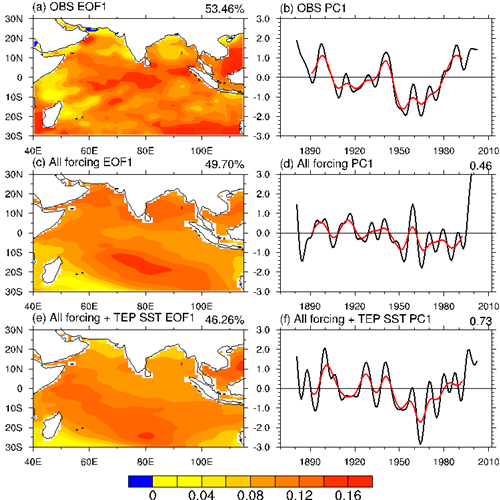The regions around the Indian Ocean are home to about one third of world’s population, with the majority living in developing countries that are highly vulnerable to climate variability and change. Sea surface temperature (SST) variations in the Indian Ocean have large impacts on rainfall and atmospheric circulation over Africa and South Asia, especially on the South and East Asian monsoons.
Indian Ocean has witnessed a significant warming trend during the twentieth century, which is revealed to be attributed to human activity. Superimposed on a pronounced warming trend, Indian Ocean SSTs also show considerable decadal variations. There are, however, few studies on the cause of the decadal SST variability in the Indian Ocean, even though many mechanisms have been proposed to explain the decadal SST variability in the Pacific and Atlantic Oceans. Improved understanding of Indian Ocean decadal SST variability can help understand and predict decadal climate variations in and around the Indian Ocean. This study aims to reveal the mechanisms responsible for the Indian Ocean decadal variability.
Recently, a group at Institute of Atmospheric Physics (IAP) led by Dr. ZHOU Tianjin and Dr. DONG Lu, in collaboration with Dr. Aiguo DAI from University at Albany, SUNY, conducted a series of numerical experiments using a state-of-the-art, fully coupled climate model CESM by prescribing the observed SSTs in the tropical eastern Pacific Ocean (TEP) for 1871–2012. The results show that as long as the observed SST in the TEP is prescribed as observation in the model, the experiments can capture the magnitude and phase transition of the decadal mode in the Indian Ocean (Fig. 1).

Fig. 1. The dominant mode of Indian Ocean decadal variability. The leading EOF pattern and associated standardized principal component (PC, black lines) of the 8-year low-pass filtered annual SST in the Indian Ocean from (a–b) HadISST, (c–d) one All forcing run, and (e–f) one All forcing + TEP SST run during 1871–2012. The SST data were linearly detrended prior to the EOF analysis. The values given on the top-right of the panels represent the explained percentage variance by this mode in (a, c, e), and the correlation coefficients with the HadISST PC in (d, f). The red lines show the 15-year low-passed filtered time series of black lines. (Dong et al., 2016)

Fig. 2. Contributions of different factors to Indian Ocean decadal and long-term changes. (a) Indian Ocean (20°S–20°N, 40°E–120°E) averaged SST decadal changes (oC) from 1951-1976 (an IPO cold phase) to 1977-1998 (an IPO warm phase) based on HadISST (OBS), the ensemble mean of the three All forcing runs (Ext), the internal variability in HadISST (int_OBS) obtained using OBS minus Ext, the ensemble mean of the three All forcing + TEP SST runs (Ext_TEP), one piControl + TEP SST run (TEP), and the effect of internal TEP SST (int_TEP) obtained using Ext_TEP minus Ext. Panel (b) is the same as (a), but for the difference between the IPO cold phase from 1999–2012 and the IPO warm phase from 1977–1998. (c) The Indian Ocean averaged SSTs linear trend (oC per 20 years) during 1951–2012.(Dong et al., 2016)
Contributions of different factors to Indian Ocean decadal variations are estimated by comparing observations with model results. Although the external forcings account for most of the warming trend, the decadal variability in Indian Ocean SSTs is dominated by internal variability that is induced by Inter-decadal Pacific Oscillation (IPO). The cold IPO weakens the warming of the external forcings by about 50% over the Indian Ocean, while warm IPO enhances the warming from external forcing (Fig. 2). Based on the analysis above, the cold IPO phase since around 1999 should impose a negative anomaly and slow down its upward trend for the Indian Ocean SST. This should contribute to the recent global warming hiatus by about 10%, although the IPO-induced cooling in the eastern pacific plays a bigger role.
Reference:
Dong Lu, Tianjun Zhou*, Aiguo Dai, Fengfei Song, Bo Wu, Xiaolong Chen, 2016:The Footprint of the Inter-decadal Pacific Oscillation in Indian Ocean Sea Surface Temperatures, Scientific Reports,6:21251, DOI:10.1038/srep21251
Contact: ZHOU Tianjun, zhoutj@lasg.iap.ac.cn







